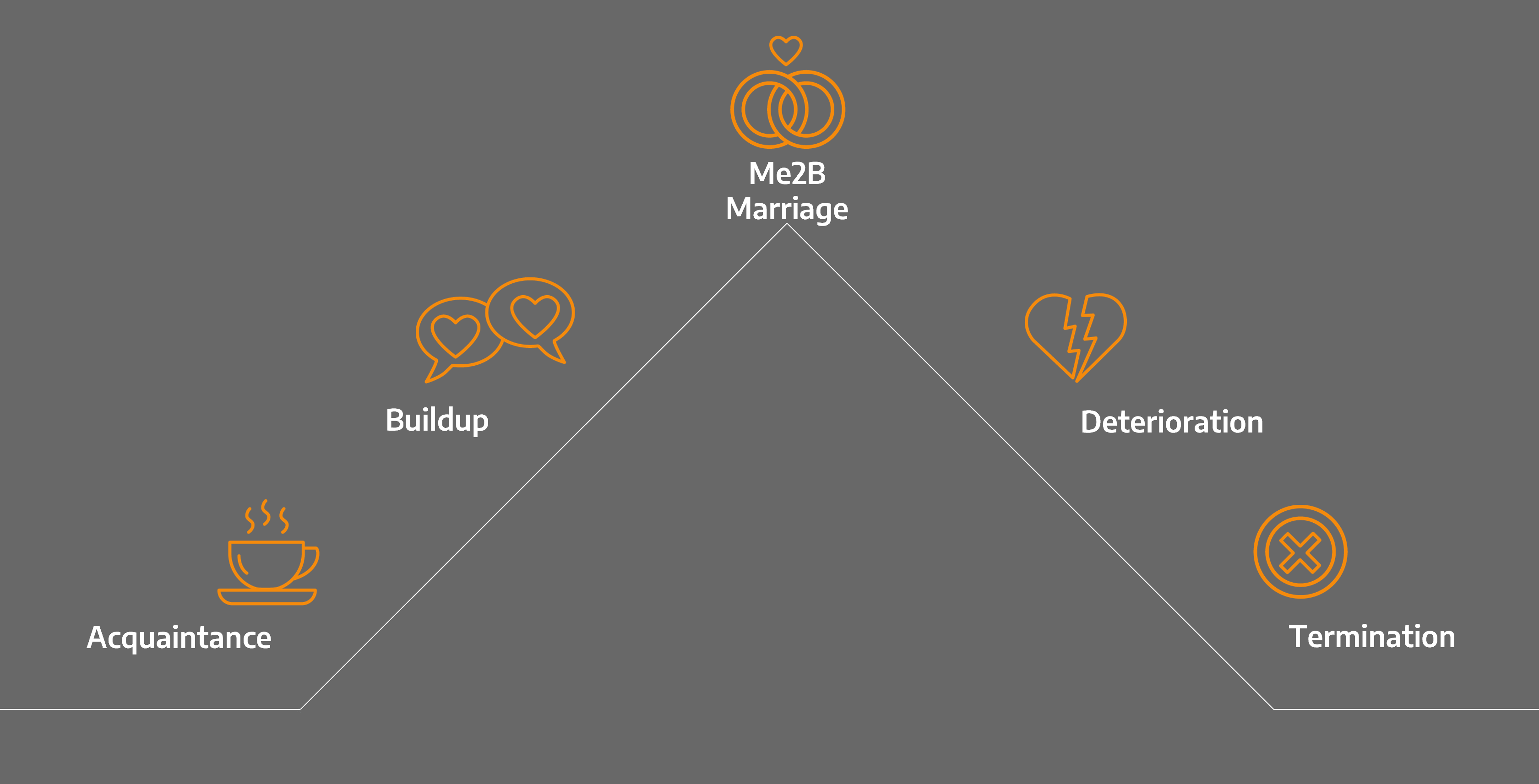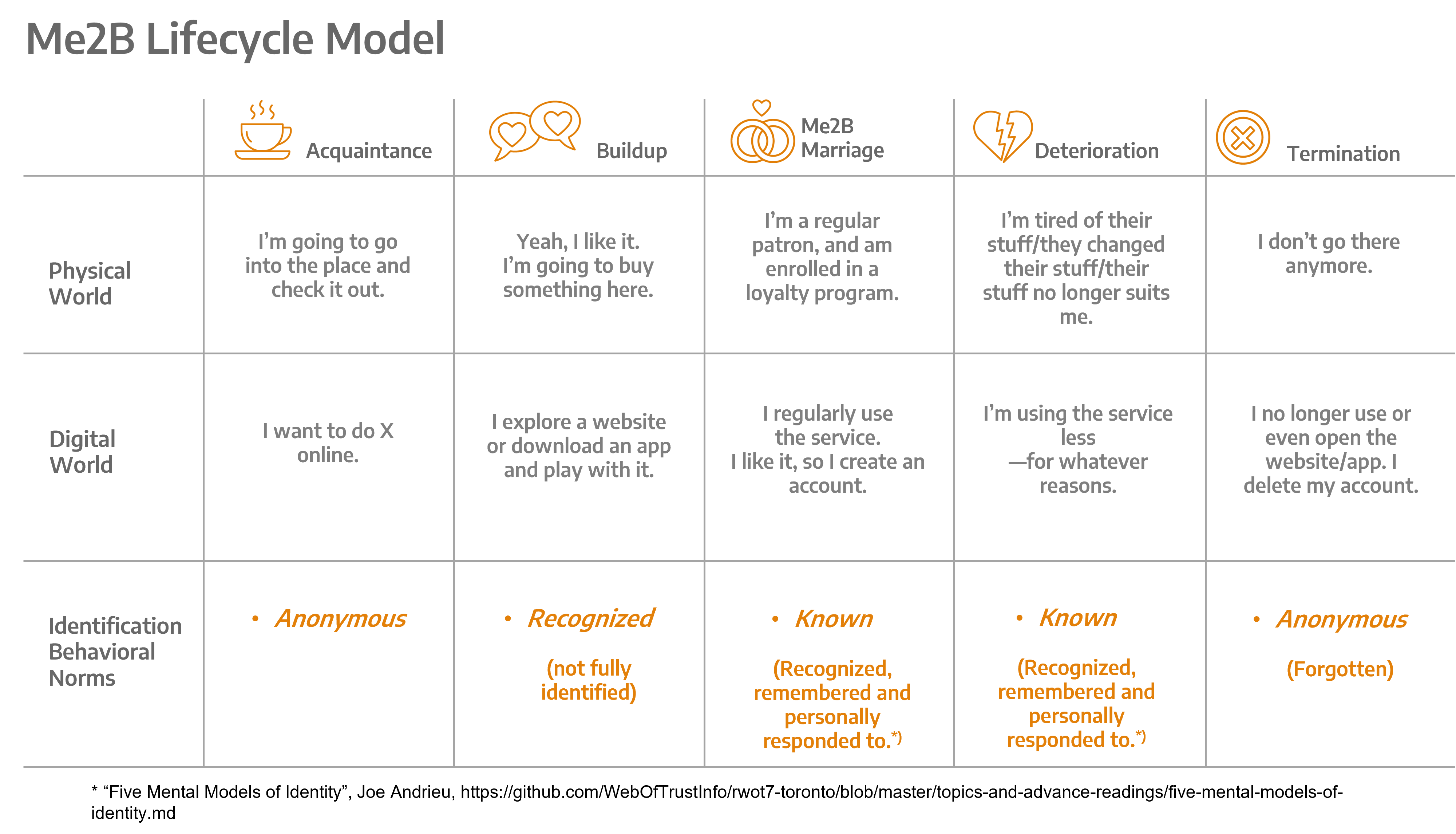Version 1.0 | September 1, 2021
#Me2BRelationship
IN A NUTSHELL
Key to creating a standard to measure the behavior of technology is the ability to take several contexts into consideration, including the current status of the Me2B relationship. The Me2B Lifecycle model provides a framework and vocabulary to articulate and account for the dynamic “relationship context” over time when evaluating the behavior of technology. This real life social context is currently missing in both existing privacy regulation and in industry standards models for ethical technology, but it is crucial to the Me2B Respectful Tech Specification. Our model helps course-correct connected technology by pinpointing how the digital Me2B experience deviates from important social behavioral norms.
The Me2B Alliance has developed a model for the lifecycle of Me2B Relationships that is rooted in interpersonal psychology. Specifically, we built on psychologist George Levinger’si ABCDE relationship model, which asserts that every relationship eventually traverses through five stages:
- Acquaintance
- Build-up
- Commitment
- Deterioration
- Ending
The Me2B Relationship Lifecycle follows a similar arc. It starts with acquaintance, and moves through a buildup of repeated interactions. Over time, if these interactions deepen in intimacy and trust, they may culminate in a deliberate deep commitment, which we call the “Me2B Marriage”, which is the point of creating an online account. Eventually, the relationship may deteriorate to the point of termination. (See Figure 7.1)

Figure 7.1 – The Me2B Relationship Lifecycle
Each stage in the Me2B Relationship Lifecycle represents a unique context that reflects the trust level and intensity of the relationship from the individual’s point of view. Figure 7.2 provides examples of how each stage of the lifecycle may look in the physical world and in the digital world.

Figure 7.2 – Me2B Relationship Lifecycle in the Physical & Digital Worlds
In the physical world, there are specific behavioral social norms and expectations for each of these stages of the Me2B Lifecycle. One doesn’t expect to be greeted by name, for instance, before any introductions have been made. Similarly, we don’t expect store employees to know our home address unless we’ve given it to them for a specific reason (such as delivery).
This real life social context is currently missing in both existing privacy regulation and in industry standards models for ethical technology, but it is crucial to the Me2B Respectful Tech Specification. Our work translates appropriate and respectful behavioral norms from the physical world onto our experiences online. Figure 7.3, below, illustrates how social norms for identification –for being anonymous, recognized, and “known” or remembered– operate in the physical world, and how they should operate in the digital world.

Figure 7.3 Identification Behavioral Norms of Me2B Relationships
What is the Me2B Marriage?
The Me2B Marriage reflects the most intimate, trusted phase of the Me2B relationship, a stage where the individual chooses to be recognized, “known” or remembered, and personally responded to. In the physical world, this implies a level of being known by the business (such as loyalty program enrollment) and the agents of the business (such as cashiers or salespeople). In the digital world, the Me2B Marriage is the legal ceremony of agreeing to the vendor’s terms of service or terms of use, which most people never readii. This is, in fact, the act of entering a legal contract between the “Me” and the “B”. Ideally, the individual is not coerced or manipulated into signing up for an account, such that the individual freely signals to the B that they wish to be remembered, recognized, and personally responded to.Currently, respectful behavioral norms from Me2B Relationships in the physical world are neither reflected nor supported in digital Me2B Relationships. The Me2B Lifecycle model serves as a tool that can help course-correct connected technology to reflect appropriate social norms and behaviors for each stage in the Me2B Relationship Lifecycle.
The Me2B Respectful Tech Specification is specifically designed to address the disconnect between offline and online behavior. The tests in the specification evaluate connected technologies for how well they are translating respectful behavioral norms from the physical world into the digital world.
- https://en.wikipedia.org/wiki/George_Levinger
- https://www.businessinsider.com/deloitte-study-91-percent-agree-terms-of-service-without-reading-2017-11#:~:text=A%20new%20Deloitte%20survey%20found,and%20conditions%20without%20reading%20them
© Me2B Alliance 2021
